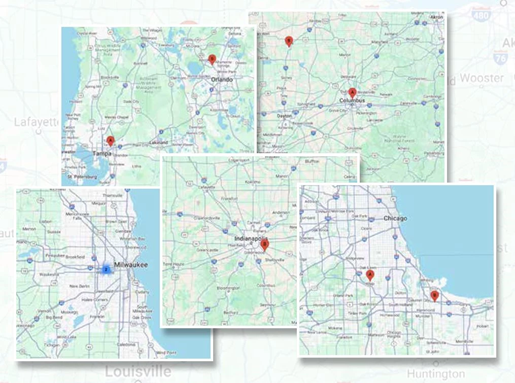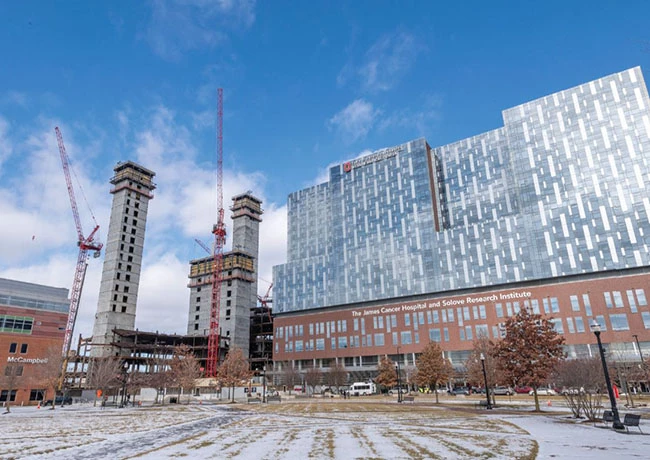
The reach of the ALL Family of Companies stretches from the balmy shores of Florida, extends up the eastern seaboard through the Southeastern U.S. and northwest to the Great Lakes into Illinois, Wisconsin, and Minnesota. Within the footprint, you find a variety of economies and demographics, as well as some surprises that defy expectation.
This diversity is among the advantages of the ALL Family. With each branch forming another link in the chain, the family of companies is strengthened by its ability to weather fluctuating market conditions. If one region of the country is experiencing a cooling economy, others are sure to be hot. We spoke with managers and key personnel at select branches to find out what’s been going on in their regions, and what they see coming in 2025. This is our report on those conversations.
ALL Sunshine Crane Rental - Orlando, Florida
T.J. Wicklander, general manager
ALL Crane Rental of Florida - Tampa, Florida
Cody Johnson, general manager
Florida’s population continues to grow at an explosive rate, adding nearly 1.1 million residents in a three-year period. The state’s 18% growth rate over the past decade and a half outpaces national population growth by nearly triple.
And all those people need places to live, work, play, roads to drive, food to eat, and utilities to power it all. ALL Sunshine Crane Rental in Orlando and ALL Crane Rental of Florida in Tampa are both reaping the rewards of projects that address all those needs and more. This includes projects building or related to condos, roads and bridges (including adding lanes to the Florida Turnpike), water treatment plants, top-secret amusement park projects in the entertainment Mecca of Orlando, and new schools for the children of families moving in. Because Florida also attracts a large retired population, there is always demand for construction of medical facilities as well.
“We see a lot of crawlers on bridge work, handling heavy beams,” said Wicklander. “We’re using them in residential work as well. We’ll have two 440-ton crawlers in the Miami area soon handling ground modifications and driving foundations for a residential high-rise.” Driving piles for seawalls is also among regularly slated work, in which 110-ton crawlers are in demand. Seventy-five-ton Link-Belt TCC-750 hydraulic crawlers are busy setting sound barrier walls for the miles of new highway the state is always adding.
"We see a lot of rough terrain crane rentals used at wastewater treatment plants,” said Johnson. “Road and bridge work keeps the 200- to 300-ton crawlers busy. Foundation people are using crawlers in the 100- to 150-ton range. All-terrain cranes are popular with bigger mechanical contractors.”
Johnson also notes a rise in grocery store construction in the Tampa area, which also requires ATs for mechanical roof work.
ALL Crane Rental Corp. - Columbus, Ohio
Rich Randall, general manager
The Midwest is seeing an explosion in the construction of data centers. These multi-acre climate-controlled buildings house the computer hard drives that protect America’s growing reliance on digital technology. ALL Crane Rental Corp. of Columbus has already been involved in several projects for well-known names in the tech world, with more in progress and even more on the way. “We’ll have dozens of cranes working on one site,” said Randall. “Often these are nine- to 12-month rentals, mostly crawlers, doing everything from foundation steel and footers to precast, structural steel, and setting major utility components on the roof.”
Many projects are scheduled for completion in phases, with total construction taking multiple years; sometimes as much as a decade. The branch is also working on a distribution center for a large e-tailer, where heavyweight crawlers in the 500- to 770-ton range are used to set “superloads” of large machinery.
Proximity to Ohio State University continues to bear fruit, with the recent completion of a three-and-half-year project involving three luffing tower cranes to add 800 beds to Wexner Medical Center. The branch is also constructing a children’s hospital on the campus, with three towers currently on site. Education in general remains strong, with projects at Otterbein, Capital, and Columbus State.
Urban construction is being driven by the various corporate headquarters located in downtown Columbus and surrounding areas. Infrastructure projects remain strong, including highway and bridge work.
Central Rent-A-Crane - Indianapolis, Indiana
Kevin Hileman, general manager
Patrick McKenzie, operations manager
Indiana has been making infrastructure news for years due to the state’s heavy investment in reimagining the highway system around its metropolitan hubs. However, the Hoosier State has been booming in general, with multiple large-scale projects in the residential, energy, and technology markets.
The Big Three automakers and a handful of their suppliers have committed substantial capital across Michigan, Indiana, Kentucky, as well as Tennessee, to build massive manufacturing plants for fuel cell batteries to support their transition to broader EV offerings.
“These projects use nearly every piece of equipment we offer in our expansive rental fleet from start to finish,” said Hileman. “Our foundation contractor customers make use of our rough terrain and telescopic crawler cranes to set rebar cages for their caissons, while both small and large lattice boom crawler cranes are put to work by steel erectors to set the structure of the buildings.”
Central Rent-A-Crane has had great success with all-terrain cranes working for months on end setting everything from roof top mounted air handling units and piping to pump houses and evaporative cooling towers for on-site water treatment facilities. Telehandlers and carry deck cranes, along with countless mobile elevating work platforms, round out the project with final machinery sets and ancillary equipment needed to put the plant online.
The next big opportunity in this space is industry-adjacent: recycling facilities to consciously dispose of and potentially reuse the waste created when these battery packs reach the end of their useful life. “It’s exciting to be on the ground floor of development on one of the first of these plants,” said McKenzie. “The critical investment by these organizations has benefitted our bottom line over the last couple of years, a trend that looks to continue into the years ahead.”
Indiana is also a burgeoning hub for data center construction, driven in part by the increasing demands of artificial intelligence. One of the primary factors making the region attractive is the relatively low cost of land. These facilities require expansive physical infrastructure to support their massive data-processing needs.
Dawes Rigging & Crane Rental - Milwaukee, Wisconsin
Ryan Harrison, general manager
In general, the Midwest offers vast, open spaces at a fraction of the cost seen in tech-heavy regions like Silicon Valley or urban hubs on the East Coast. Dawes’ coverage area, which includes four total branches as well as trucking arm DST (Dawes Special Transport), extends to two major metropolitan areas, both Milwaukee, Wis. and Minneapolis-St. Paul, Minn. Perhaps surprising for Midwest metro areas, both are experiencing a population boom – and Dawes’ projects often reflect the support needed to handle such an influx. This includes residential high-rise construction, power generation plants to boost grid capacity, educational facilities, and medical centers.
“We’re fortunate; this part of the country doesn’t seem to experience wild swings in the market,” said Harrison. “Southern Wisconsin, in particular, has always had a little bit of everything. It’s allowed us to weather changing economic winds perhaps better than other regions.”
A previous boom in ethanol production plants and wind farms has quieted down, but work at food processing plants has risen to take its place. “Most likely attributable to work that was postponed during COVID ramping back up now.”
The technology-related sectors have remained strong as well, with a major software manufacturer redeveloping land left empty by an electronics manufacturer. “We’re also seeing lithium-ion battery production facilities. Warehousing, schools, and hospitals are popping back up,” said Harrison. “The only thing we’re not seeing as much is commercial. Retail areas are stagnant. But it’s been replaced by residential and mixed use.”
For commercial construction projects across the region, tower cranes are staying busy, as are crawlers in the 100-ton to 300-ton weight classes. And across all market segments, rough terrain cranes are in constant demand, especially units between 40- ton to 100-tons. The truck crane fleet, including ATs, has been working nonstop for the majority of the year. “We’ve also seen a rise in operated rentals. There’s a shortage of operators, and the unions are doing their best to address this, but customers are currently turning to us to fill that gap.”
Central Contractors Service
John Martello, general manager
Paul Urbanski, sales manager
It’s been an up-and-down year for the usually thriving Chicago area, but 2024 is ending on a decidedly “up” note that is expected to carry into the new year. In years past, Central Contractors Service averaged nearly 20 tower cranes erected at any given time. Lately it’s been roughly a quarter of that.
But Central – and indeed the whole of ALL – is much more than towers. That diversity of product and diversity in the customer base has enabled the branch to weather some storms. “Infrastructure has kept us strong,” said Martello. “We worked on new bridges all summer long. Work on the Illinois Tollway has remained consistent. ”
Manitowoc MLC300 lattice boom crawler cranes with VPC-MAX were in demand for bridge work. “Contractors really like them because of the smaller footprint and no need to use a wheeled MAX-ER attachment,” said Urbanski.
Telecrawlers, including the 140-ton Link-Belt TCC-1400 and 250-ton Link-Belt TCC-2500, have been in high demand due to their versatility. “We can’t keep telecrawlers in the yard because they’ve been so popular with general contractors,” said Martello. “The TCC-2500 is really popular with its high capacity and versatility to move around a job site without having to disassemble and re-assemble like a traditional lattice boom crawler.”
“The vast inventory of the ALL Family has helped us pivot in seeking revenue with other avenues,” said Urbanski.
Looking ahead to 2025, there will be a project to expand O’Hare International Airport, as well as related infrastructure improvements to corridors from the west. Northwestern University in nearby Evanston is building a new football stadium, a nine-month project. Precast contractors are booking new warehouse construction within Chicago proper for next summer into fall. “The city’s reputation as a central shipping hub has made it popular for storage and distribution centers,” said Martello.
Reticent developers have also indicated that some long-dormant projects may come roaring back in the new year. “There’s a good possibility some of them will start taking off by the second quarter,” said Urbanski.
At least a half-dozen new data centers are on the horizon, as well. That’s in addition to the six already under construction in the region.
Towers are even making a comeback. In January, a major tech company begins renovations to Chicago landmark the Thompson Center. A tower crane from Central will be there.
“We’re fortunate to have a diverse group of customers who work in a lot of sectors,” said Urbanski. “If one sector closes, we can look to another to lift us up.”

